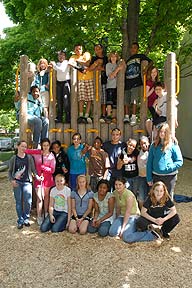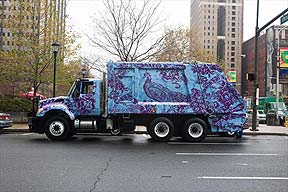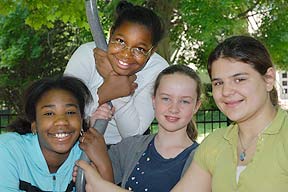Picture it now...
Imagine City officials and members of the ARTWalk2 Steering Committee- the group that’s heading up the extension of  University Avenue’s treasured art trail- listening attentively to an hour’s worth of passionate, articulate, and thoughtful recommendations on the sort of public art that Rochester should invest in. Imagine that the remarks they heard didn’t come from design professionals or neighborhood groups. They didn’t come from a nationally-renowned public art specialist or a mayor from a city famous for its public art.
University Avenue’s treasured art trail- listening attentively to an hour’s worth of passionate, articulate, and thoughtful recommendations on the sort of public art that Rochester should invest in. Imagine that the remarks they heard didn’t come from design professionals or neighborhood groups. They didn’t come from a nationally-renowned public art specialist or a mayor from a city famous for its public art.
Now, imagine that the presentation that held the attention of everyone in the room came from sixth graders. Imagination became reality in May 2009 as students showcased findings of their year-long research project on public art.
The sixth grade class at the Genesee Community Charter School (GCCS) at the Rochester Museum and Science Center on East Avenue weaved a theme into their presentation that urged local leaders in the room to “imagine” a Rochester revitalized by public art that sprinkles its streets, dots its parks, and even dresses up its infrastructure. Students told the ARTWalk2 team to consider fun, surprising pieces of art that force passers-by to, well, stop passing by.
“Art should make us slow down and think…it should inspire us,” observed Zhanna Thompson of northwest Rochester. Zhanna’s classmates made a case for art with a light element that can serve as a bright beacon during an otherwise dark and long Rochester winter. They pressed us to incorporate water elements into the art since our city proudly boasts a river, canal, and Great Lake flowing through it.
Art in Unexpected Places
 The sixth graders asked us to imagine art as more than an obvious sculpture placed on a sidewalk, but rather, as a part of a sidewalk in the form of a decorative stamp or cast iron manhole cover. Art like this that’s incorporated into parts of the public infrastructure (the “hardscape”) like sidewalks, bridges, benches, drinking fountains, and even garbage cans is a long-lasting and subtle illustration that our city can make even the most mundane things interesting.
The sixth graders asked us to imagine art as more than an obvious sculpture placed on a sidewalk, but rather, as a part of a sidewalk in the form of a decorative stamp or cast iron manhole cover. Art like this that’s incorporated into parts of the public infrastructure (the “hardscape”) like sidewalks, bridges, benches, drinking fountains, and even garbage cans is a long-lasting and subtle illustration that our city can make even the most mundane things interesting.
Anastesia Brown, of southwest Rochester, especially likes when traffic control boxes are decorated, like the ones in her neighborhood around Genesee Street. When art covers an otherwise ordinary object like the traffic control boxes or garbage trucks, it dresses up objects that normally go unnoticed.
One of the best parts of the presentation was that the students had not learned all that they shared from Googling and viewing art from their computer screen. They split up into groups and actually visited four cities around the country to examine the art first-hand. Philadelphia, Washington D.C., Minneapolis, and even Seattle played host to the GCCS students. In addition to walking amongst the art, they made stops at city halls and spoke with the public officials responsible for making public art a priority in the cities.
Beyond Something to Look At
Taking cues from the cities they toured, the students at GCCS imagined art in Rochester that does more than serve an aesthetic purpose but can actually make a neighborhood feel safer and give residents a reason to take better care of their surroundings.
 Gena Driscoll-Brantley, of southwest Rochester, ventured to Philadelphia with classmates and saw some of the 3,000 murals that grace buildings all across the city. The Mural Arts Program and the city-sponsored Public Arts Program began as a way to curb graffiti. “The program keeps high school students busy during the summer and gives them an alternative to hanging out on the streets,” Gena said. “Plus,” she went on, “art tends to create safe spots in neighborhoods that might not always be so safe.” In Philadelphia, giving young people an opportunity to express themselves ended up curbing crime as well: out of the thousands of murals in Philadelphia, less than 1% have graffiti.
Gena Driscoll-Brantley, of southwest Rochester, ventured to Philadelphia with classmates and saw some of the 3,000 murals that grace buildings all across the city. The Mural Arts Program and the city-sponsored Public Arts Program began as a way to curb graffiti. “The program keeps high school students busy during the summer and gives them an alternative to hanging out on the streets,” Gena said. “Plus,” she went on, “art tends to create safe spots in neighborhoods that might not always be so safe.” In Philadelphia, giving young people an opportunity to express themselves ended up curbing crime as well: out of the thousands of murals in Philadelphia, less than 1% have graffiti.
And, the students pointed out, art is not just for the locals: it draws visitors. "If Rochester had more public art, it would make the city a welcoming gathering spot", Emma Wagner, of northwest Rochester, offered.
If the first portion of ARTWalk is any indicator, Emma is right. ARTWalk is high on the list of fun places to bring out of town visitors. Emma wants Rochester to up its ante of public art so that her and her friends will want to live here after college which, she admits, seems far off since they are all bubbling over the anticipation of their first year of high school.
A Lasting Impression
Without a doubt, the ARTWalk2 Steering Committee left the auditorium imagining all of the possibilities the students suggested. As they begin to design the project and select the art that will adorn the extension of University Avenue, committee members have promised to incorporate some of the sixth graders’ ideas.
Thankfully, you don’t have to "imagine" a city where the grown-ups actually listen to the young people...you’re living in it.
Learn more about becoming a part of the art!